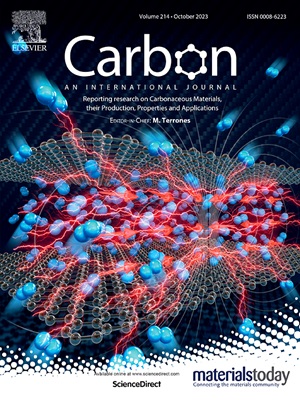Carbon nitride embedded in carbon layer with interconnected porous nanosheets structure for solar-driven photocatalytic reaction
IF 10.5
2区 材料科学
Q1 CHEMISTRY, PHYSICAL
引用次数: 0
Abstract
The implementation of multiple strategies that involve constructing a beneficial morphological structure and coupling with the thermal field can significantly promote photogenerated charge separation in carbon nitride (CN) and enhance solar irradiation utilization, which are effective approaches to improve its solar-driven photocatalytic reaction efficiency. CN embedded in carbon layer with an interconnected nanosheet architecture was obtained by coaxial electrostatic spraying. In which, carbon layer not only exhibit photothermal effects: elevating the surface/interface temperature of material and accelerating the thermodynamic rate of reactions, but also offer expedited pathways for the photogenerated charges. In addition, the interconnected nanosheets, with a thickness of ∼30 nm and abundant mesoporous-dominated porosity, also facilitate rapid mass transfer processes. The hydrogen evolution reaction (HER) rate of the composite photocatalyst used for solar-driven water splitting reached 6.48 mmol h−1 g−1 and it demonstrated good cyclic stability and remarkable dye degradation efficiency. Photoelectrochemical test results indicated that, catalysts featuring an embedded structure of interconnected nanosheets can effectively reduce ohmic resistance and suppress the recombination of photogenerated charges. Ultimately, the intrinsic mechanisms underpinning this enhancement were elucidated through theoretical calculations. This work introduces novel strategies and perspectives for multi-field synergy in the pursuit of efficient solar-driven water splitting for HER.
氮化碳包埋在碳层中,具有互连多孔纳米片结构,用于太阳能驱动的光催化反应
构建有利的形态结构并与热场耦合的多种策略的实施可以显著促进氮化碳(CN)的光生电荷分离,提高太阳辐照利用率,是提高其光催化反应效率的有效途径。采用同轴静电喷涂的方法,获得了具有互联结构的碳层内嵌CN。其中,碳层不仅表现出光热效应,提高了材料的表面/界面温度,加快了反应的热力学速率,而且为光生电荷提供了加速的途径。此外,互连的纳米片厚度为~ 30 nm,具有丰富的介孔为主的孔隙率,也有利于快速传质过程。该复合光催化剂的析氢反应速率达到6.48 mmol h−1 g−1,具有良好的循环稳定性和染料降解效率。光电化学测试结果表明,具有互连纳米片嵌入结构的催化剂可以有效地降低欧姆电阻,抑制光生电荷的重组。最后,通过理论计算阐明了支撑这种增强的内在机制。这项工作介绍了在追求高效太阳能驱动的HER水分解的多领域协同作用的新策略和观点。
本文章由计算机程序翻译,如有差异,请以英文原文为准。
求助全文
约1分钟内获得全文
求助全文
来源期刊

Carbon
工程技术-材料科学:综合
CiteScore
20.80
自引率
7.30%
发文量
0
审稿时长
23 days
期刊介绍:
The journal Carbon is an international multidisciplinary forum for communicating scientific advances in the field of carbon materials. It reports new findings related to the formation, structure, properties, behaviors, and technological applications of carbons. Carbons are a broad class of ordered or disordered solid phases composed primarily of elemental carbon, including but not limited to carbon black, carbon fibers and filaments, carbon nanotubes, diamond and diamond-like carbon, fullerenes, glassy carbon, graphite, graphene, graphene-oxide, porous carbons, pyrolytic carbon, and other sp2 and non-sp2 hybridized carbon systems. Carbon is the companion title to the open access journal Carbon Trends. Relevant application areas for carbon materials include biology and medicine, catalysis, electronic, optoelectronic, spintronic, high-frequency, and photonic devices, energy storage and conversion systems, environmental applications and water treatment, smart materials and systems, and structural and thermal applications.
 求助内容:
求助内容: 应助结果提醒方式:
应助结果提醒方式:


